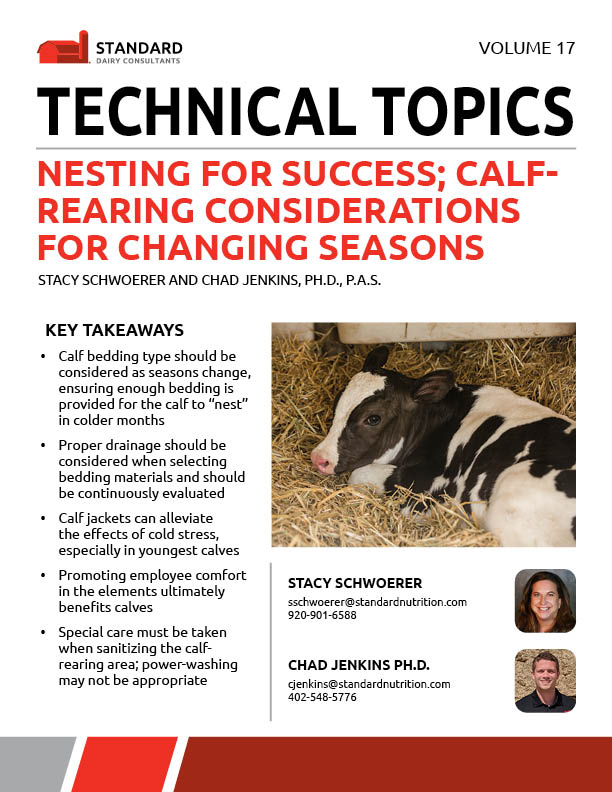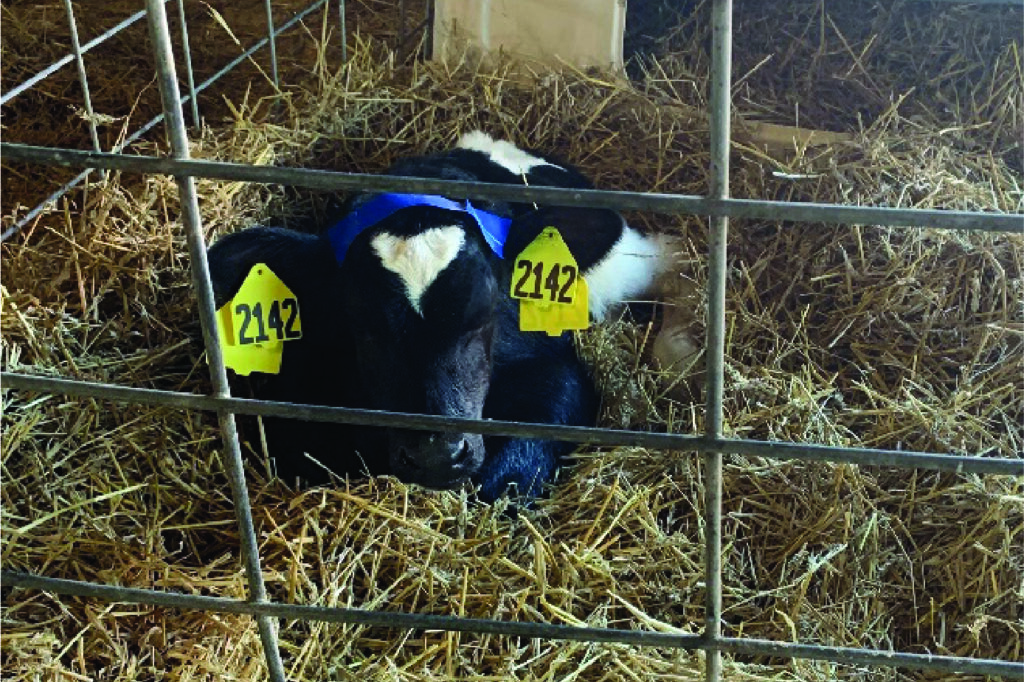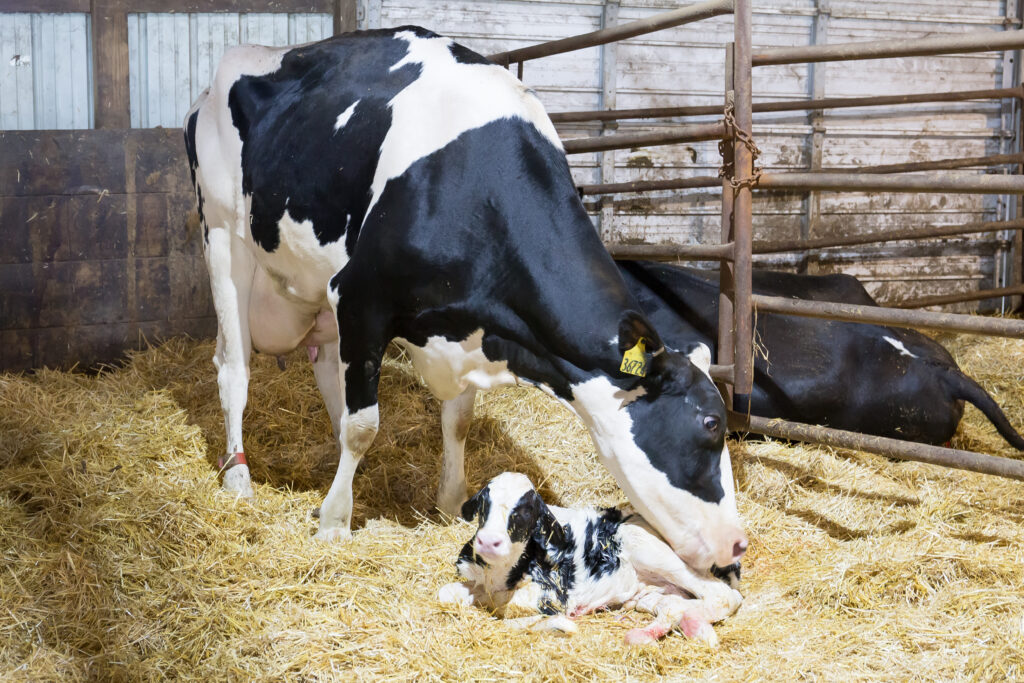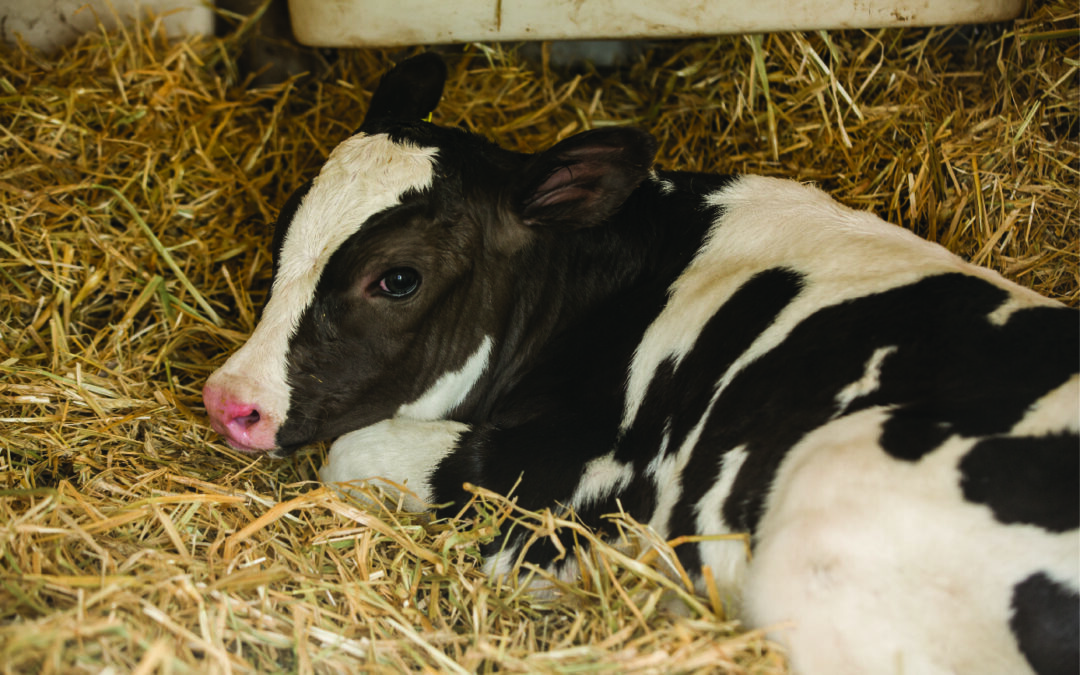Written by: Stacy Schwoerer and Chad Jenkins, Ph.D., P.A.S.
KEY TAKEAWAYS IN THIS ISSUE OF TECHNICAL TOPICS:
- Calf bedding type should be considered as seasons change, ensuring enough bedding is provided for the calf to “nest” in colder months
- Proper drainage should be considered when selecting bedding materials and should be continuously evaluated
- Calf jackets can alleviate the effects of cold stress, especially in youngest calves
- Promoting employee comfort in the elements ultimately benefits calves
- Special care must be taken when sanitizing the calf-rearing area; power-washing may not be appropriate

Those of us that are parents may remember the “nesting phase”; those several anticipatory (and sometimes frantic) months prior to the arrival of a newborn when cribs are meticulously assembled, diapers are neatly stacked, and nurseries are generally made ready to care for a new life to the best of our abilities. Imagine our dairy calves’ future productivity and success if we adapted a similar preparatory mentality!
Speaking of “nesting,” as cooler fall months are quickly approaching, it is a timely exercise to evaluate bedding requirements in the nursery (calf-rearing area). While shavings or sand may be excellent bedding choices for Summer, they are not adequate for colder temperatures – the structure and composition of straw provide thermal insulation for the baby calf by trapping warm air around the body and allowing for proper “nesting,” which prevents energy loss and frostbite. About one foot of long straw should be provided; a good rule of thumb is that around 2/3rds of the calf’s legs should be hidden by the bedding while lying down.
However, similar to the overfilled diaper bin in the baby’s room, drainage problems can present a host of messy issues. One drawback of straw bedding is that it holds onto moisture. Therefore, it is advantageous to start with a base layer of shavings or similar material to help wick away moisture from the calf. A simple test of bedding effectiveness is to kneel with your full weight into the calf bedding. Any sight of wetness on your coveralls indicates that the bedding is too wet and should be addressed (this technique is not recommended to evaluate drainage near the diaper bin). Identifying areas that are prone to puddles or are difficult to clean should also be near the top of the list for corrective action leading to winter, as icing will undoubtedly exacerbate these issues.

Excessive energy loss resulting from a calf struggling to maintain body temperature results in poor growth performance by increasing the calf’s maintenance energy requirement. So how cold is too cold for a newborn calf? A calf has a thermoneutral zone between 60 and 77 degrees Fahrenheit, so it is prudent to consider bedding material changes when lows begin to consistently fall below this range. In addition to bedding materials, calf jackets may be employed as an effective strategy to help the calf maintain body temperature. Calf jackets are especially effective for calves under three weeks of age, as the rumen has not yet fully developed to begin fermenting grain and producing heat. In general, calf jackets should be put on when temperatures fall below 50 degrees F for several consecutive nights and removed when ambient temperatures are over 60, especially in younger calves. When calves are in jackets for extended cold periods, it is important to remember to adjust straps to adjust to their growth.
Other considerations when setting up the nursery pertain to convenience and ease of use for mom and dad (rocking-recliner is a must); the same train of thought should apply to our calf-rearing employees. For example, are our protocols practical for removing water and milk from the calf-rearing area? Feeding calves is difficult even in good weather, so creative ways to improve protocols or prepare equipment for winter will go a long way in improving efficiency, consistency, and employee morale with which the job is completed. Some examples include insulating milk feeding tanks, investing in windbreaks for the side-by-side, or even something as simple as providing a stash of hand warmers for employees. If employees are expected to work in the elements, it is to the calves’ benefit that the workers are comfortable.
Parents know, no nursery stays clean for long once the baby arrives, and proper cleaning equipment should be close-at-hand. The same goes for the calf-rearing area, where proper sanitation is essential for preventing the spread of disease and promoting healthy growth. When cleaning calf pens, a temptation may be to fire up the trusty pressure washer and blast all foreign material right out of the door (again, not recommended in baby’s room). While pressure washing may be satisfying, it may also exacerbate issues with the spread of infectious disease as microbes are “aerosolized” and spread to other surfaces throughout the barn. A better approach is to utilize a foam applicator with alkaline detergent (pH of 11 to 12). After soaking with alkaline foam, rinse with water, and repeat with foaming acid (pH 3 to 4). After final rinsing, pens should be allowed to dry thoroughly. For further details, readers are referred to sanitation protocols developed by Dr. Donald Sockett of the Wisconsin Veterinary Diagnostic Laboratory HERE.

In conclusion, careful preparation of the nursery and calf-rearing area alike lead to healthy newborns. The changing seasons is a great time to re-evaluate protocols and best practices, as winter often introduces new challenges or amplifies existing issues. A conversation with your SDC Consultant may provide new ideas or insights for successful calf-rearing. They can connect you to a vast network of resources to ensure your calf-rearing area is set up to start your future milking herd off right.
References are available upon request.
Everything you ever wanted to know about DCAD and related minerals
Written by: Chad Jenkins, PhD
How does DCAD work?
The acid-base (pH) balance in blood is a strictly regulated metabolic system, however, pH may be influenced by levels of cations (positively charged ion) and anions (negatively charged ion) present in the diet. All cations and anions in a diet can influence pH, but are predominantly driven by the cations sodium (Na) and potassium (K), and the anions chloride (Cl) and sulfur (S). Therefore, the cation and anion difference in a diet (DCAD) is used to express the balance of these minerals and is calculated by the equation:
(Na+ + K+) – (Cl– + SO-24)
Cations in the diet (left side of the equation) will cause the blood to become alkaline (increase pH), while anions (right side of the equation) will cause the blood to become acidic (decrease pH). When diets are balanced to a negative DCAD (more Cl and S), slightly acidic conditions in the blood cause an increase in calcium (Ca) excretion in the urine. As a result, processes regulating calcium homeostasis are “kickstarted” to increase blood calcium: first, the parathyroid gland releases parathyroid hormone, which signals calcidiol (25-hydroxyvitamin D3) to be converted to calcitriol (1,25-dihydroxycholecalciferol) in the kidney. Next, calcitriol stimulates the activity of a protein called calbindin, which helps to bind calcium in the intestinal cells. As a result, calcium absorption from the diet is increased. Because mature cows have fewer vitamin D receptors and osteoclasts (cells responsible for resorption from bone), a negative dietary DCAD is an effective strategy to aid in calcium homeostasis at calving (this is why DCAD is not necessary for first-calf heifers).
How is DCAD monitored on-farm?
Urinary pH is a proxy for blood pH, therefore it may be used to monitor the effectiveness of the dietary DCAD balance. The average urine pH in a pen of close-up cows receiving a DCAD diet should fall between 6.2 and 6.8. While lower pHs have been advocated for, pHs below 6 may be detrimental for several reasons, including the potential for reduced DMI resulting from metabolic acidosis or palatability issues with anions, increased likelihood of developing a displaced abomasum (Mecitoglu et al., 2016), and increased risk of stillborns (Melendez et al., 2021). Additionally, at low urine pH, the kidneys begin to initiate the process of ammoniagenesis (ammonia production) in an attempt to increase pH, which requires the amino acid glutamate. Finally, mounting evidence suggests that blood calcium concentration does not continue to increase at urine pH below 6.
Dietary Calcium Considerations
Dietary calcium is important for transition cows, but in the context of a DCAD diet, it is important to remember that calcium carbonate (CaCO3) is an alkalizing agent (think “Tums”). As a result, excessive dietary calcium (>1.8% dietary DM) may actually work against the desired acidification effects of a negatively-balanced DCAD diet. In fact, this is likely why cows with a urine pH below 6 respond positively to rations balanced with higher levels of calcium.
Dietary Phosphorus Considerations
Excessive phosphorus (P) levels should also be avoided (>0.35% dietary DM) in close-up rations, as blood phosphorus concentrations are also regulated by calcitriol in a manner that works against calcium absorption; when blood phosphorus levels are elevated, a hormone found in bone called fibroblast growth factor-23 (FGF23) suppresses calcitriol synthesis. A reduction in calcitriol synthesis works against the mechanism that the DCAD strategy relies on to increase calcium absorption discussed above.
Dietary Magnesium Considerations
Increasing dietary Magnesium in transition cows has been shown to reduce the risk of milk fever (~0.4% dietary DM). Because they supply anions, magnesium sulfate (MgSO4) and magnesium chloride (MgCl2) may be good magnesium sources for the close-up cow receiving a negatively-balanced DCAD diet. After calving, magnesium oxide (MgO) can help serve as a rumen alkalizer as the cow consumes increasing amounts of fermentable carbohydrates.
In conclusion, negatively-balanced DCAD diets are an excellent strategy for preventing milk fever and associated metabolic issues in transition cows, as well as promoting improved milk production performance after calving. The DCAD strategy has the unique advantage of near-instant feedback in its effectiveness by way of urine pH monitoring and is one of the many ways your Standard consultant or assistant may bring value to your nutrition program.


